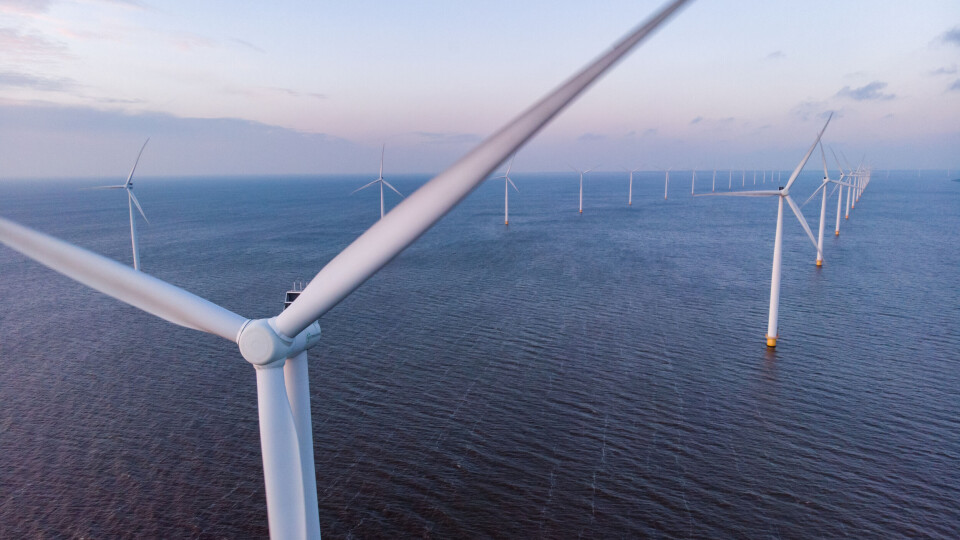-
More than 5,000 French communes use AI to identify poor rubbish sorting
Badly-sorted rubbish can cost millions so communes are turning to high-tech solutions
-
Tax on well-off retirees under consideration for 2026 budget
‘Nothing is off the table’ when it comes to finding €40 billion in savings says Labour Minister
-
Nice airport records passenger boom as tourists flock to city
Airport figures exceeded the pre-Covid record last year, with US visitors significant contributors
President Macron opens France’s first offshore wind farm
The farm is one of several set to launch in the next few years and is part of the country’s plans to catch up with European neighbours on wind-produced energy

President Emmanuel Macron has opened the first French offshore wind farm today (September 22), as he presents his ‘major plans’ for renewable energy production.
The 80-turbine wind farm is off the coast of Saint-Nazaire in Loire-Atlantique; more specifically, between 12-20km off the coasts of Pouliguen and Croisic.
The farm is managed by EDF, and will enter into service by the end of the year. It will produce 480 megawatts (MW), and be capable of providing enough electricity for 700,000 people.
👀 La construction du parc éolien en mer de Saint-Nazaire continue... Depuis plusieurs semaines les éléments éoliens sont chargés à bord du Vole Au Vent. Cette opération XXL à ciel ouvert mobilise activement les outillages et le savoir-faire de nombreux acteurs portuaires. pic.twitter.com/e0vCjzZKNX
— NantesStNazairePort (@nantesport) May 24, 2022
Mr Macron’s renewable energy proposals will be presented to the cabinet on September 26. It comes after he set an objective, in February this year, for France to have 40 offshore wind farms over the coming years.
He said that his aim was for the country to have “40 gigawatts in service by 2050”, and to “strengthen energetic sovereignty”. This is especially relevant at a time when energy prices are soaring and the war in Ukraine is putting energy sources at risk.
How many wind turbines are currently operating in France?
There are just under 9,000 wind turbines producing electricity in France currently. Development has increased over the past 10 years and this number has doubled since 2014.
Wind turbines are most common in Hauts-de-France and Grand-Est. Together, these departments account for 50% of the connected capacity in France. The least-developed regions for wind turbine technology are Île-de-France, Provence-Alpes-Côte-d'Azur, and Corsica.
New wind farms are set to open by 2024 in Saint-Brieuc, Fécamp, and Courseulles-sur-Mer.
#EolienEnMerFecamp La France s’est fixée un objectif de neutralité carbone d’ici 2050.🌱Sept parcs #éoliens posés doivent être mis en service entre 2022 et 2028 : Saint-Nazaire, Saint-Brieuc, #Fécamp, #CourseullessurMer, Île-d'Yeu-Noirmoutier, Dieppe-Le Tréport et Dunkerque.🚧 pic.twitter.com/Wh8dsbXz6e
— Parc éolien en mer de Fécamp (@EolienMerFecamp) April 29, 2022
How does France compare with its European neighbours?
France is behind in comparison to wind power share in other European countries. In France, wind power made up just less than 8% of the electricity in 2020, behind hydroelectric dams and nuclear power. Nuclear still represents almost 70% of French production.
In contrast:
- Germany and Spain: 20%+
- United Kingdom: 30%
- Portugal: 40%
- Denmark: 60%
So far, the average time it takes to get an offshore wind farm into service in France is 10 years, compared to five in Germany, and six in the UK. For land wind farms, the time is seven years, double the average time for Spain and Germany.
Why is France behind?
Firstly, because of a delay in starting up. The first wind turbine was only installed in France in the early 1990s. Several European countries, such as Germany and Denmark, had already launched large-scale production at that time.
Secondly, because of appeals against wind turbine projects, which have delayed construction for several years.
Plans to catch up
France is now working hard to catch up.
Jérémy Simon, deputy general delegate of the Syndicat des énergies renouvelables told newspaper Ouest France: "The offshore wind farm has new and very strong power potential. After Saint-Nazaire, a new wind farm will be commissioned each year.”
In contrast, President Macron has slowed down the development of onshore wind power, with a doubling of current capacity over 30 years rather than the previously-stated 10.
He has also announced a new push on power from other sources, including the construction of six EPR2 reactors by 2035, and a tenfold increase in installed solar power capacity by 2050.
Wind farm technology is politically controversial in France, with the far-right parties historically against the plans. In her presidential campaign, Rassemblement National candidate Marine Le Pen pledged to stop all development plans and “ban all wind farms” if she had been elected.
Related articles
Which departments in France have the most wind farms?
Le Pen: Is her plan to ban all French wind farms realistic?
France issues call for tenders for its first ever floating wind farms
























